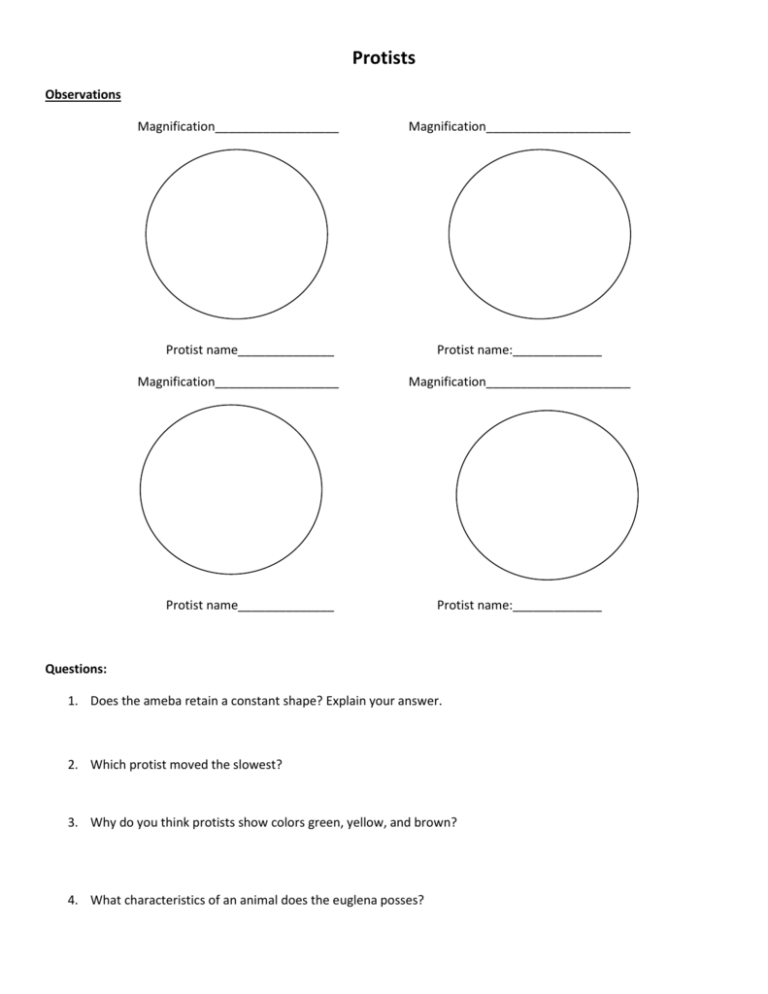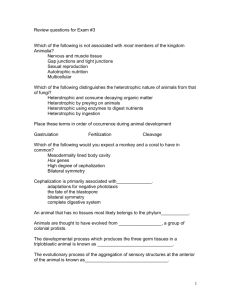Protists
advertisement

Protists Observations Magnification__________________ Magnification_____________________ Protist name______________ Magnification__________________ Protist name:_____________ Magnification_____________________ Protist name______________ Protist name:_____________ Questions: 1. Does the ameba retain a constant shape? Explain your answer. 2. Which protist moved the slowest? 3. Why do you think protists show colors green, yellow, and brown? 4. What characteristics of an animal does the euglena posses? 5. How do the eyespot and the chloroplasts work together to help the euglena survive? 6. Some of the white blood cells in your body show ameboid movement. What does this mean? 7. Why is it important for a photosynthetic organism to live near the surface of a body of water? 8. Euglenas are generally autotrophic organisms. Why does this characteristic make the euglena a good choice for use in the biology laboratory? 9. Give one ecological benefit of algae. 10. What is the function of the central vacuole? 11. Where are protists found? Sponges and Hydras Observations: Grantia Grantia, Longitudinal Section Magnification:_____ Hydra, Whole Mount Magnification:________ Grantia Spicules Magnification:_____ Hydra, Longitudinal Section: Magnification:________ Discussion Questions: Hydra and Sponges 1) How does a sponge get oxygen and food? ___________________________________________________________________________________________ _________________________________________________________________ 2) What is the function of the spicules of the sponge? ___________________________________________________________________________________________ _________________________________________________________________ 3) What was the purpose of the chlorine bleach solution in Part A of the investigation? ___________________________________________________________________________________________ _________________________________________________________________ 4) What body structures make the sponge well adapted for living in water? ___________________________________________________________________________________________ _________________________________________________________________ 5) What is the function of the gastrovascular cavity of the hydra? ___________________________________________________________________________________________ _________________________________________________________________ 6) Compare the sponge and hydra in terms of body symmetry and tissue structure. ___________________________________________________________________________________________ _________________________________________________________________ 7) How does a sponge differ from flagellate protists? ___________________________________________________________________________________________ _________________________________________________________________ 8) Why do you think a Grantia sponge should not be used to wash a car? ___________________________________________________________________________________________ _________________________________________________________________ 9) How did the discovery and production of artificial sponges change the population if natural sponges? ___________________________________________________________________________________________ _________________________________________________________________ 10) “Cnid” is the Greek word for nettle, or stinging hair. Is the phylum name Cnidaria appropriate to the group of organisms such as hydra and jellyfishes? Explain. ___________________________________________________________________________________________ _________________________________________________________________ Flatworms and Roundworms Magnification:_____ Planarian (Dugesia) Magnification:_____ Vinegar Eel (Turbatrix) Magnification:_____ Tapeworm (Taenia) Magnification:_____ Trichinella Flatworm and Roundworm Discussion Questions 1) How do flatworms and roundworms differ in body structure? ___________________________________________________________________________________________ _________________________________________________________________ 2) How are flatworms similar to roundworms in body structure? ___________________________________________________________________________________________ _________________________________________________________________ 3) Why are structures for locomotion lacking in parasitic flatworms and roundworms? ___________________________________________________________________________________________ _________________________________________________________________ 4) Would the nervous and digestive systems be more complex in free-living forms or the parasitic forms of the flatworms and roundworms? Explain. ___________________________________________________________________________________________ _________________________________________________________________ 5) Why is the term “eyespot” instead of eye used when referring to the structure at the anterior end of the planarian body? ___________________________________________________________________________________________ _________________________________________________________________ 6) List two advantages that parasitic worms have over free-living worms. ___________________________________________________________________________________________ _________________________________________________________________ 7) Why is it rare hat an individual parasite will kill a host? ___________________________________________________________________________________________ _________________________________________________________________ 8) You have taken a job as a product inspector in a large meat packing company. As your first assignment, you must inspect pork for the presence of trichina worms. What should you look for? ___________________________________________________________________________________________ _________________________________________________________________ EARTHWORM Label Anatomy of the Earthworm External Anatomy Internal Anatomy Discussion Questions: Earthworm 1) Describe the shape of the dorsal and ventral surfaces of the earthworm’s body. ___________________________________________________________________________________________ _________________________________________________________________ 2) 3) 4) 5) 6) How many segments are in your earthworm? _________________________________ In which segments is the clitella located?___________________________________ Where are setae located in the earthworm?__________________________________ How many setae are on each segment?______________________________________ Why is it important to not make a deep cut with the scissors when dissecting your earthworm specimen? ___________________________________________________________________________________________ _________________________________________________________________ 7) How does the earthworm’s digestive system adapt it to filtering food out of the soil? ___________________________________________________________________________________________ _________________________________________________________________ 8) Describe two ways in which an earthworm’s body is adapted to life in the soil. ___________________________________________________________________________________________ _________________________________________________________________ 9) Describe one way that an earthworm is poorly adapted to life on land. ___________________________________________________________________________________________ _________________________________________________________________ 10) How might an earthworm’s lack of appendages be an adaptation to burrowing? ___________________________________________________________________________________________ _________________________________________________________________ 11) Explain how an earthworm enriches and aerates the soil, thus improving it for plant growth. ___________________________________________________________________________________________ _________________________________________________________________ MOLLUSCA Squid Discussion Questions: 1. KingdomPhylumClass2. What is the Latin meaning of the phylum and class? 3. How do squid protect themselves from predators? 4. What happened when you rubbed the chromatophores? 5. Where does squid fit into the marine food web? 6. What role does the squid play in the ocean ecosystem? 7. What adaptations does the squid have that allow it to play that role? 8. Have you ever used a squid for food or as fish bait? What were you trying to catch? 9. Describe the function of each of the following parts: Fin Chromatophores Eye Arms and Tentacles Suction cups Pen Mantle Gonad Heart Gills Inc sac Siphon ARTHROPODA CHARACTERISTIC Legs present Number of leg pairs Legs jointed Body in regions Abdomen segmented Appendages on abdomen Eyes present Antennae present Number antennae Wings present Mouth parts present Telson present Type of respiratory system Location of nerve cord Location of heart Name of excretory organ Similar digestive system Exoskeleton present Type of circulatory system Sexes separate CLASS INSECTA (GRASSHOPPER) CLASS CRUSTACEA (CRAYFISH) IS TRAIT SIMILAR FOR BOTH CLASSES? YES OR NO 1. Compare the movement of the grasshopper’s jaws to those of humans. 2. Describe the texture of the grasshopper’s exoskeleton. 3. How do simple and compound eyes differ? 4. Compare the forelegs and jumping legs in terms of structure and size. 5. What sex is your grasshopper? How can you tell? 6. List two characteristics of chitin that make it a good material for the exoskeleton and wings of arthropods. 7. How is the grasshopper adapted to detect moving objects in the environment? 8. What are the mouthparts of a grasshopper adapted to do? 9. Of the three body regions of the grasshopper which one is specialized for locomotion? 10. What do you think is the function of the spine like structures found on the tibia and tarsus? 11. How can a grasshopper’s exoskeleton be both and advantage and disadvantage? 12. List three structures of the grasshopper that are adaptations for life on dry land. 13. Most insects are small as compared to most vertebrates. Do you think being small is more of an advantage or disadvantage to insects? Give evidence to support their answer. 14. Explain how grasshoppers dig holes to lay their eggs. FROG 1. Describe the color of the dorsal and ventral surfaces of the frog. 2. Is your frog male or female? How can you tell? 3. Where is the tongue attached to the mouth? 4. How many lobes does the liver contain? 5. What is the shape of the stomach? 6. Describe the mesentery that holds the intestines. 7. Describe the inside wall of the stomach. 8. Describe the contents of the frog’s stomach. 9. Compare the walls of the two atria and the ventricle. AtriaVentricle10. Describe the movement of the leg muscles as the leg is bent and straightened. 11. Frogs are insect eaters. How is the frog’s tongue designed for the type of food it eats? 12. List three adaptations that permit the frog to live on land successfully. a. b. c. 13. List three adaptations that permit the frog to live in water successfully. a. b. 14. The frog’s sense organs are located on top of the head. How does this help the frog when it is in the water? FETAL PIG FETAL PIG DISSECTION LAB ANALYSIS QUESTIONS Pig lab #1- External Anatomy 1. What is meant by gestation period? 2. What is the approximate age of your pig? 3. How does a fetus get rid of its waste products? 4. What types of external features are used to separate mammals into orders? 5. What goes in and out of the external nares? 6. What is another word for pinna? What is its function? 7. What is another name for the chest region of the pig? 8. What is another name for the “belly” region of the pig? Pig lab #2- Oral Cavity 1. Why is the sense of taste and smell important to organisms? 2. What is the function of the epiglottis? 3. What substances are secreted by oral cavity of humans that aid digestion? Name these substances and tell what each does to help digestion. 4. The esophageal opening is top of which tube? Where does this tube lead? Pig lab #3- Digestive System 1. Describe the intestinal mesentery. 2. In humans, what structure is found at the junction of the small and large intestine? 3. What is the posterior opening of the digestive tract called? The anterior opening? 4. How many lobes (sections) does the liver have? 5. Where does the bile duct lead to and what substance does it carry? 6. List the function of each Stomach Esophagus Small intestine Large intestine Pancreas Liver Gall bladder 7. What structure separates the thoracic cavity from the abdominal cavity? Spasms of this muscle cause what problem? 8. What is an ulcer? 9. What is done in an appendectomy? Through which cavity does the surgeon enter? Pig Lab #4- Circulatory System 1. Which is larger, the right or left ventricle? Why? 2. To what structure do the pulmonary arteries lead? 3. Why are arteries larger than veins? 4. What are the primary functions of the circulatory system? 5. In humans, what results when a valve is leaving blood backwards in the heart? 6. Why is it so difficult to get into the heart during surgery? Pig lab #5- Respiratory System 1. Describe the exchange of gases in the lungs. 2. What is the primary function of the respiratory system? 3. Why do you think the bronchi branch extensively into tiny airtubes? 4. Carbon dioxide is exhaled from the lungs. How is it produced? Pig lab #6- Urogenital System 1. What is the function of the kidneys? How many does the pig have? 2. Where are the kidneys located? 3. Describe the function of each of the following and label them male or female. Body part Ovary Testis Uterine horn Vagina Epididymis Urethra M/F Function Pig lab #7- Nervous System 1. What is the function of the cranium? 2. Describe the function of the following: Cerebrum Cerebellum Olfactory lobe Medulla Oblongata 3. When a person suffers from a stroke, what happens?




